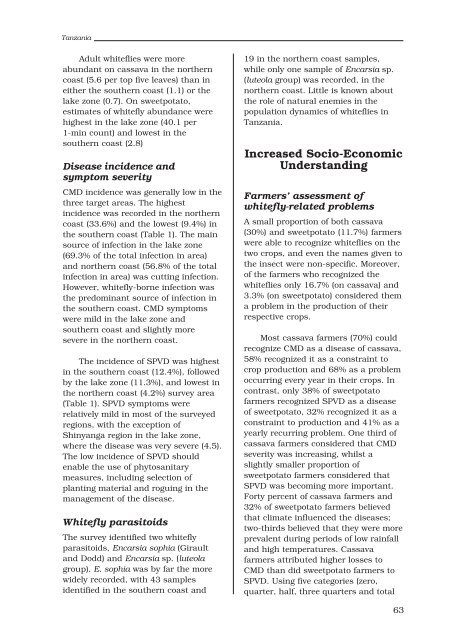Whitefly and whitefly-borne viruses in the tropics : Building a ... - cgiar
Whitefly and whitefly-borne viruses in the tropics : Building a ... - cgiar
Whitefly and whitefly-borne viruses in the tropics : Building a ... - cgiar
Create successful ePaper yourself
Turn your PDF publications into a flip-book with our unique Google optimized e-Paper software.
Tanzania<br />
Adult whiteflies were more<br />
abundant on cassava <strong>in</strong> <strong>the</strong> nor<strong>the</strong>rn<br />
coast (5.6 per top five leaves) than <strong>in</strong><br />
ei<strong>the</strong>r <strong>the</strong> sou<strong>the</strong>rn coast (1.1) or <strong>the</strong><br />
lake zone (0.7). On sweetpotato,<br />
estimates of <strong>whitefly</strong> abundance were<br />
highest <strong>in</strong> <strong>the</strong> lake zone (40.1 per<br />
1-m<strong>in</strong> count) <strong>and</strong> lowest <strong>in</strong> <strong>the</strong><br />
sou<strong>the</strong>rn coast (2.8)<br />
Disease <strong>in</strong>cidence <strong>and</strong><br />
symptom severity<br />
CMD <strong>in</strong>cidence was generally low <strong>in</strong> <strong>the</strong><br />
three target areas. The highest<br />
<strong>in</strong>cidence was recorded <strong>in</strong> <strong>the</strong> nor<strong>the</strong>rn<br />
coast (33.6%) <strong>and</strong> <strong>the</strong> lowest (9.4%) <strong>in</strong><br />
<strong>the</strong> sou<strong>the</strong>rn coast (Table 1). The ma<strong>in</strong><br />
source of <strong>in</strong>fection <strong>in</strong> <strong>the</strong> lake zone<br />
(69.3% of <strong>the</strong> total <strong>in</strong>fection <strong>in</strong> area)<br />
<strong>and</strong> nor<strong>the</strong>rn coast (56.8% of <strong>the</strong> total<br />
<strong>in</strong>fection <strong>in</strong> area) was cutt<strong>in</strong>g <strong>in</strong>fection.<br />
However, <strong>whitefly</strong>-<strong>borne</strong> <strong>in</strong>fection was<br />
<strong>the</strong> predom<strong>in</strong>ant source of <strong>in</strong>fection <strong>in</strong><br />
<strong>the</strong> sou<strong>the</strong>rn coast. CMD symptoms<br />
were mild <strong>in</strong> <strong>the</strong> lake zone <strong>and</strong><br />
sou<strong>the</strong>rn coast <strong>and</strong> slightly more<br />
severe <strong>in</strong> <strong>the</strong> nor<strong>the</strong>rn coast.<br />
The <strong>in</strong>cidence of SPVD was highest<br />
<strong>in</strong> <strong>the</strong> sou<strong>the</strong>rn coast (12.4%), followed<br />
by <strong>the</strong> lake zone (11.3%), <strong>and</strong> lowest <strong>in</strong><br />
<strong>the</strong> nor<strong>the</strong>rn coast (4.2%) survey area<br />
(Table 1). SPVD symptoms were<br />
relatively mild <strong>in</strong> most of <strong>the</strong> surveyed<br />
regions, with <strong>the</strong> exception of<br />
Sh<strong>in</strong>yanga region <strong>in</strong> <strong>the</strong> lake zone,<br />
where <strong>the</strong> disease was very severe (4.5).<br />
The low <strong>in</strong>cidence of SPVD should<br />
enable <strong>the</strong> use of phytosanitary<br />
measures, <strong>in</strong>clud<strong>in</strong>g selection of<br />
plant<strong>in</strong>g material <strong>and</strong> rogu<strong>in</strong>g <strong>in</strong> <strong>the</strong><br />
management of <strong>the</strong> disease.<br />
<strong>Whitefly</strong> parasitoids<br />
The survey identified two <strong>whitefly</strong><br />
parasitoids, Encarsia sophia (Girault<br />
<strong>and</strong> Dodd) <strong>and</strong> Encarsia sp. (luteola<br />
group). E. sophia was by far <strong>the</strong> more<br />
widely recorded, with 43 samples<br />
identified <strong>in</strong> <strong>the</strong> sou<strong>the</strong>rn coast <strong>and</strong><br />
19 <strong>in</strong> <strong>the</strong> nor<strong>the</strong>rn coast samples,<br />
while only one sample of Encarsia sp.<br />
(luteola group) was recorded, <strong>in</strong> <strong>the</strong><br />
nor<strong>the</strong>rn coast. Little is known about<br />
<strong>the</strong> role of natural enemies <strong>in</strong> <strong>the</strong><br />
population dynamics of whiteflies <strong>in</strong><br />
Tanzania.<br />
Increased Socio-Economic<br />
Underst<strong>and</strong><strong>in</strong>g<br />
Farmers’ assessment of<br />
<strong>whitefly</strong>-related problems<br />
A small proportion of both cassava<br />
(30%) <strong>and</strong> sweetpotato (11.7%) farmers<br />
were able to recognize whiteflies on <strong>the</strong><br />
two crops, <strong>and</strong> even <strong>the</strong> names given to<br />
<strong>the</strong> <strong>in</strong>sect were non-specific. Moreover,<br />
of <strong>the</strong> farmers who recognized <strong>the</strong><br />
whiteflies only 16.7% (on cassava) <strong>and</strong><br />
3.3% (on sweetpotato) considered <strong>the</strong>m<br />
a problem <strong>in</strong> <strong>the</strong> production of <strong>the</strong>ir<br />
respective crops.<br />
Most cassava farmers (70%) could<br />
recognize CMD as a disease of cassava,<br />
58% recognized it as a constra<strong>in</strong>t to<br />
crop production <strong>and</strong> 68% as a problem<br />
occurr<strong>in</strong>g every year <strong>in</strong> <strong>the</strong>ir crops. In<br />
contrast, only 38% of sweetpotato<br />
farmers recognized SPVD as a disease<br />
of sweetpotato, 32% recognized it as a<br />
constra<strong>in</strong>t to production <strong>and</strong> 41% as a<br />
yearly recurr<strong>in</strong>g problem. One third of<br />
cassava farmers considered that CMD<br />
severity was <strong>in</strong>creas<strong>in</strong>g, whilst a<br />
slightly smaller proportion of<br />
sweetpotato farmers considered that<br />
SPVD was becom<strong>in</strong>g more important.<br />
Forty percent of cassava farmers <strong>and</strong><br />
32% of sweetpotato farmers believed<br />
that climate <strong>in</strong>fluenced <strong>the</strong> diseases;<br />
two-thirds believed that <strong>the</strong>y were more<br />
prevalent dur<strong>in</strong>g periods of low ra<strong>in</strong>fall<br />
<strong>and</strong> high temperatures. Cassava<br />
farmers attributed higher losses to<br />
CMD than did sweetpotato farmers to<br />
SPVD. Us<strong>in</strong>g five categories (zero,<br />
quarter, half, three quarters <strong>and</strong> total<br />
63
















